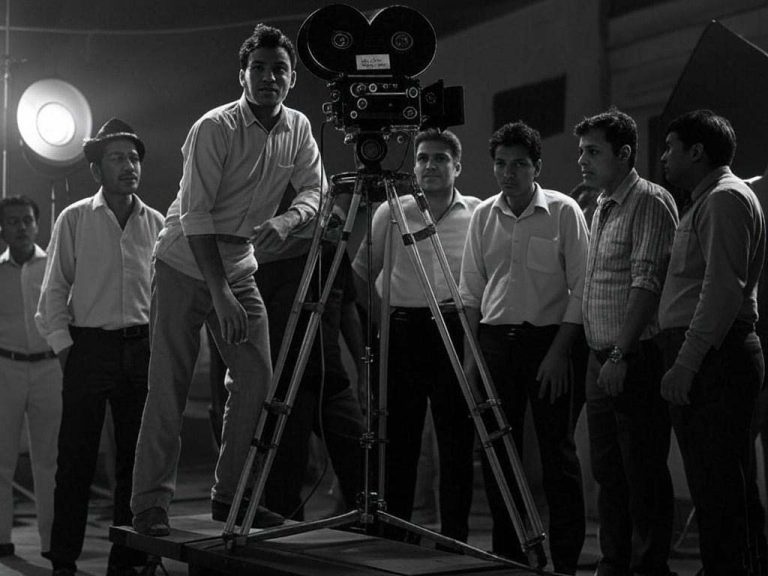By Michael McKown
In the rich tapestry of Indian cinema, particularly within the vibrant landscape of Bollywood, the quest to identify the “best Hindi movie of all time” is as much a celebration of film as it is a tribute to the cultural narratives that have shaped Indian society. Film critics, with their discerning eyes and deep understanding of cinematic art, have often debated this topic, yet a film that consistently rises to the pinnacle of acclaim is Guru Dutt’s Pyaasa (1957).
Pyaasa stands as a cinematic masterpiece not only for its time but enduringly so, weaving together elements of drama, music, and existential reflection with unparalleled finesse. Directed by Guru Dutt, who also stars in the lead role, Pyaasa captures the essence of a disillusioned poet navigating the harsh realities of a society that values material success over artistic integrity. The film’s narrative is a poignant critique of the socio-economic conditions of post-independence India, a theme that resonates across decades.
The plot revolves around Vijay, played by Guru Dutt, a poet whose verses are profound reflections of his inner turmoil and the societal decay he witnesses. Despite his talent, Vijay faces rejection from a world that has little room for idealism, particularly in the bustling, often cruel, city of Bombay (now Mumbai). His journey through love, loss, and eventual resurrection from the ashes of despair is both tragic and redemptive. The film’s title, Pyaasa (meaning “thirsty” in Hindi), metaphorically represents Vijay’s longing for recognition, love, and a society that nurtures rather than destroys.
One of the key elements that elevate Pyaasa in the eyes of critics is its visual storytelling. Guru Dutt, known for his meticulous direction, uses light and shadow to great effect, creating a visual language that speaks of despair, hope, and the human condition. The use of black and white not only adds to the film’s timeless quality but also enhances the stark contrast between the protagonist’s inner world and the external chaos. Scenes like the one where Vijay walks through the red-light district, or his encounter with the beggar who recites his poetry back to him, are etched in the memory of cinema lovers for their poetic and poignant use of visuals.
The music of Pyaasa, composed by S.D. Burman with lyrics by Sahir Ludhianvi, is another pillar supporting its status as a cinematic gem. Songs like Ye Duniya Agar Mil Bhi Jaaye To Kya Hai and Jinhen Naaz Hai Hind Par Wo Kahan Hain are not merely musical interludes but are integral to the narrative, voicing the film’s themes of disillusionment with society and the quest for true human values. These songs have transcended the film itself, becoming anthems for those who resonate with the film’s critique of societal norms.
Critics have also lauded the performances in Pyaasa. Waheeda Rehman’s portrayal of Gulabo, the empathetic sex worker with a heart of gold, adds layers to the narrative, offering a counter-narrative to Vijay’s cynicism. The chemistry between Dutt and Rehman, coupled with their individual performances, provides the emotional depth necessary for Pyaasa to resonate on a personal level with its audience. Supporting roles by actors like Johnny Walker and Rehman bring comic relief and further depth, making the film’s world richly textured.
Moreover, Pyaasa is celebrated for its narrative structure, which was ahead of its time in Indian cinema. The film does not shy away from showing the darker sides of society, including exploitation and corruption, yet it does so with a poetic grace that makes its critique both beautiful and biting. The film’s ending, where Vijay is pronounced “dead” only to be reborn through the recognition of his work, symbolizes a powerful commentary on the often-posthumous appreciation of true art.
Pyaasa is often hailed by film critics as the best Hindi movie of all time due to its masterful blend of art, social commentary, and human emotion. Its influence on subsequent generations of filmmakers and its continued relevance in discussions about cinema and society make it not just a film, but a cultural artifact of immense value. Guru Dutt’s Pyaasa remains a beacon of Indian cinema, illuminating the path for those who believe in the transformative power of art.
My name is Michael McKown and I’m the co-founder and president of Ghostwriters Central, Inc. My company is located in Southern California, USA. We have screenwriters for hire to help those with an idea for a film but need expert assistance to get the script written. If we can help you, all you need to do is click the link. पढ़ने के लिए धन्यवाद, स्वस्थ रहें।

